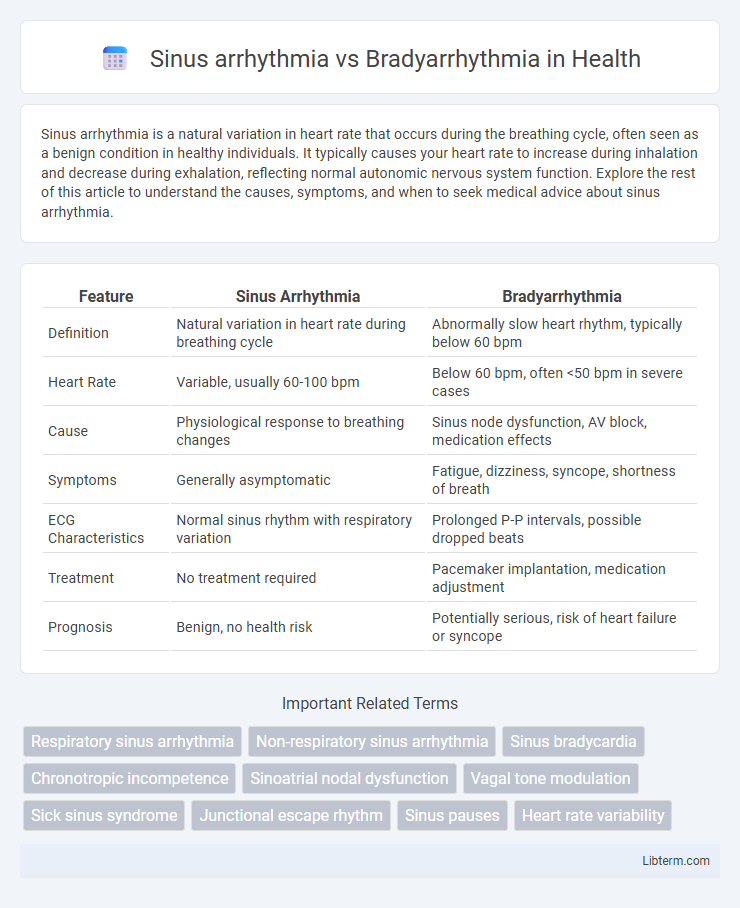Sinus arrhythmia is a natural variation in heart rate that occurs during the breathing cycle, often seen as a benign condition in healthy individuals. It typically causes your heart rate to increase during inhalation and decrease during exhalation, reflecting normal autonomic nervous system function. Explore the rest of this article to understand the causes, symptoms, and when to seek medical advice about sinus arrhythmia.
Table of Comparison
| Feature | Sinus Arrhythmia | Bradyarrhythmia |
|---|---|---|
| Definition | Natural variation in heart rate during breathing cycle | Abnormally slow heart rhythm, typically below 60 bpm |
| Heart Rate | Variable, usually 60-100 bpm | Below 60 bpm, often <50 bpm in severe cases |
| Cause | Physiological response to breathing changes | Sinus node dysfunction, AV block, medication effects |
| Symptoms | Generally asymptomatic | Fatigue, dizziness, syncope, shortness of breath |
| ECG Characteristics | Normal sinus rhythm with respiratory variation | Prolonged P-P intervals, possible dropped beats |
| Treatment | No treatment required | Pacemaker implantation, medication adjustment |
| Prognosis | Benign, no health risk | Potentially serious, risk of heart failure or syncope |
Understanding Sinus Arrhythmia
Sinus arrhythmia is a natural variation in heart rate that occurs during the breathing cycle, often seen as a benign increase in heart rate during inhalation and a decrease during exhalation. This condition differs significantly from bradyarrhythmia, which involves an abnormally slow heart rate typically caused by issues such as sinoatrial node dysfunction or heart block. Understanding sinus arrhythmia helps in distinguishing normal physiological heart rate fluctuations from pathological slow rhythms requiring medical intervention.
Defining Bradyarrhythmia
Bradyarrhythmia is characterized by an abnormally slow heart rate, typically less than 60 beats per minute, due to dysfunctional electrical impulses in the sinoatrial node or atrioventricular conduction system. Unlike sinus arrhythmia, which involves a normal variation in heart rate related to breathing patterns, bradyarrhythmia can lead to inadequate cardiac output and symptoms like dizziness, fatigue, or syncope. Common types of bradyarrhythmias include sinus node dysfunction and atrioventricular block, both requiring clinical evaluation for potential pacemaker therapy.
Key Differences Between Sinus Arrhythmia and Bradyarrhythmia
Sinus arrhythmia is characterized by a natural variation in heart rate during a breathing cycle, typically maintaining a normal rhythm with rate changes linked to inhalation and exhalation. Bradyarrhythmia refers to an abnormally slow heart rate, usually below 60 beats per minute, causing symptoms like fatigue, dizziness, or syncope due to impaired cardiac output. Key differences include sinus arrhythmia's benign, physiological nature with variable heart rate fluctuation, whereas bradyarrhythmia represents pathological slow rhythm requiring medical assessment and possible intervention.
Causes of Sinus Arrhythmia
Sinus arrhythmia primarily results from variations in vagal tone affecting the sinoatrial node, often linked to respiratory cycles where heart rate increases during inspiration and decreases during expiration. This physiological phenomenon is common in young, healthy individuals and is influenced by autonomic nervous system activity, particularly parasympathetic modulation. Unlike bradyarrhythmia, which involves abnormally slow heart rates often due to sinoatrial node dysfunction or conduction system disease, sinus arrhythmia is typically benign and reflects normal cardiac rhythm variability.
Causes of Bradyarrhythmia
Bradyarrhythmia primarily results from impaired sinoatrial node function, atrioventricular block, or conduction system disease, often influenced by ischemic heart disease, myocardial infarction, or medication effects such as beta-blockers and calcium channel blockers. Other common causes include electrolyte imbalances, hypothyroidism, and intrinsic degenerative fibrosis of the cardiac conduction system. Unlike sinus arrhythmia, which is typically a benign variation in heart rate due to respiratory cycles, bradyarrhythmia can lead to symptomatic bradycardia and require clinical intervention.
Symptoms Comparison: Sinus Arrhythmia vs Bradyarrhythmia
Sinus arrhythmia typically presents with mild symptoms such as occasional palpitations or a noticeable irregular heartbeat during breathing cycles, often remaining asymptomatic in healthy individuals. In contrast, bradyarrhythmia manifests more severe symptoms including dizziness, fatigue, fainting episodes, and shortness of breath due to the abnormally slow heart rate reducing cardiac output. Understanding the symptom differences is crucial for diagnosing conditions like respiratory sinus arrhythmia versus pathological bradyarrhythmias such as sick sinus syndrome or atrioventricular block.
Diagnostic Methods for Arrhythmias
Electrocardiogram (ECG) is the primary diagnostic tool for identifying sinus arrhythmia, revealing characteristic heart rate variability linked to respiration. Bradyarrhythmia diagnosis often requires Holter monitoring or event recorders to capture intermittent slow heart rhythms and potential pauses. Electrophysiological studies may be utilized for detailed assessment of conduction pathways in complex arrhythmias.
Clinical Significance of Sinus Arrhythmia and Bradyarrhythmia
Sinus arrhythmia is a common, usually benign variation in heart rate associated with the respiratory cycle, often seen in healthy individuals and typically requiring no treatment. Bradyarrhythmia, characterized by an abnormally slow heart rate below 60 beats per minute, may indicate underlying cardiac conduction system disease and can lead to symptoms such as dizziness, fatigue, or syncope, necessitating clinical evaluation and possible intervention like pacemaker implantation. Distinguishing between these arrhythmias is crucial for appropriate management, as sinus arrhythmia generally reflects physiological variability while bradyarrhythmia often signifies pathological processes.
Treatment Approaches for Both Arrhythmias
Sinus arrhythmia treatment typically requires no intervention as it is often a normal physiological response, but symptomatic cases may benefit from addressing underlying causes such as electrolyte imbalances or medication adjustments. Bradyarrhythmia treatment involves pacemaker implantation when symptomatic bradycardia or heart block is present, aiming to restore adequate heart rate and prevent syncope or heart failure. Pharmacologic therapy with atropine or isoproterenol can provide temporary relief in bradyarrhythmia before permanent pacing is established.
Prognosis and Long-term Outcomes
Sinus arrhythmia generally has a benign prognosis with no significant impact on long-term outcomes, often seen as a normal physiological variation, especially in younger individuals. Bradyarrhythmia may indicate underlying conduction system disease, carrying a variable prognosis that depends on severity and symptomatology, with severe cases potentially requiring pacemaker implantation to prevent complications such as syncope or heart failure. Long-term outcomes in bradyarrhythmia patients improve significantly with appropriate management, whereas sinus arrhythmia typically does not necessitate treatment or affect overall mortality.
Sinus arrhythmia Infographic

 libterm.com
libterm.com